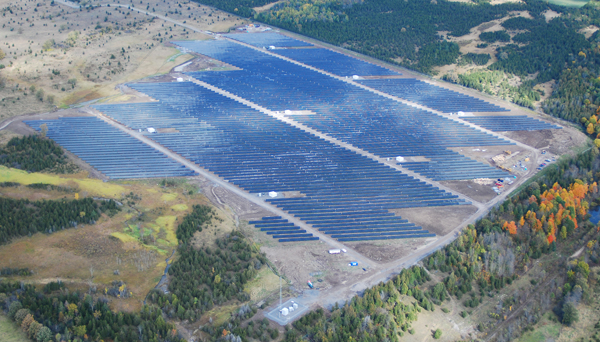Ontario has come a long way from the days in the 1980s when the nation’s, not just the province’s photovoltaic power supply was basically found in off-grid applications like remote tourist lodges, telecommunications repeaters, and galvanic protection for pipelines. For a time, the Coast Guard was the largest consumer of PV modules. Peter Carrie, who now works for First Solar (see also page 24), observed in a telephone interview that in the early 2000s he ran a small PV installation company in California that by itself installed more PV capacity – 2.5 MW in small rooftop installations – than the whole of Canada during the same period.

How things have changed.
Part of the evolution, of course, has been the flowering of the technology, from its early days when expensive and technically demanding single-crystal silicon was the only choice, to the current conditions in which many distinct varieties of solar cells are available (see “The evolution of PV technology,” p. 28).
Along with the multitude of technical options, now there are dozens of companies, large and small, contending to build grid-connected PV projects, and the forms of business arrangements have multiplied as well. First Solar, which developed the (for the present at least) largest single PV installation in the world, the 80 MW solar farm near Sarnia, does not own the installations it builds. First Solar bought the Sarnia project, along with Optisolar Farms Canada, which initiated it, and developed the field with a prior agreement to sell it to Enbridge. The contract has First Solar, which makes the cells using thin-film technology, providing a performance guarantee and operation and maintenance (O&M) for the first ten years, with an option to renew.
In Ontario’s climate, with its frequent rainfall to wash the modules clean, O&M consists primarily of keeping the vegetation down. In fact, the project scores extra points with local stewardship agencies by restoring the land to the original tall-grass prairie habitat, and by having consolidated several ecologically fragmented woodlots. (See “First Solar and the Sarnia solar farm,” page 24, for additional notes on First Solar and its Sarnia PV project. See also “Enbridge, First Solar announce more,” page 24.)
SunEdison, another PV manufacturer active in Ontario’s solar sector, takes an entirely different view on the optimal business model. It takes a position filling many more stages in the PV value chain: from manufacturer through vendor, installer, construction contractor, financier and owner-operator.
“As a solar energy provider that’s been in operation since 2003,” says Michael Dilworth, SunEdison’s VP of Project Finance, “we have developed strong expertise in all of these functions. In fact we often partner with other providers and developers who may not have the same breadth of experience to help them deliver on their projects. In addition, one of our core strengths lies in our monitoring and operating capabilities. Because we are rewarded on the amount of energy we produce, SunEdison has a strong incentive to ensure that our systems are performing at maximum capacity. As a result, we have four monitoring centers around the world that operate on a 24 hour basis that help to raise our energy production rates on a global scale.”
SunEdison may own a system it’s developed, sell another outright, and place a third in one of its partnership funds, Dilworth adds. In particular, SunEdison has been focusing on PV installations on large rooftops, of over 40,000 square feet or 100 kW in size, of which it currently has several in operation or under development for companies such as CanFirst Capital Management and GE Capital. Some of these it owns, leasing the space from the building owner, and some it has transferred to the property owner.
A story in a recent issue of this magazine described another project structure, under which one solar farm is partitioned into multiple ownership units, each sold to a different investor, in a manner perhaps reminiscent of a wind cooperative. (See “Solar tracking PV to be installed cookie-cutter style” IPPSO FACTO, February 2011.)
And the City of Toronto itself will shortly be building and owning PV installations on several of its properties (see “City to build solar power,”page 29.
The Ontario scene with respect to manufacture and supply has certainly grown as well. Thanks in large part to the FIT and RESOP programs, and the local content requirements of the FIT program in particular, an increasing number of manufacturers, engaged in lamination of the simpler types of cell construction, in module assembly, inverters, racks, tracking systems, etc, are interested in setting up in Ontario. SunEdison, for example, is building its own factory for polycrystalline panels in Newmarket, just north of Toronto, and produces its own proprietary racking systems with Samco Solar, a Scarborough-based automotive equipment manufacturer. It has also opened an office in downtown Toronto, currently with a staff of forty.
The province may have to contend with a few challenges in its effort to become the home to a large number of PV manufacturers with a world mandate. Ontario is a relatively small market internally, for the purposes of supporting a manufacturing sector, and the FIT program is provincial only, not national. On the other hand, the US is part of the market that manufacturers have access to when they locate in Ontario. The next year or two will tell a very important tale for the future of PV in Ontario.
Related stories in this feature:
What’s behind Ontario’s PV boom?
Enbridge, First Solar announce more projects
First Solar and the Sarnia solar farm
The evolution of PV technology
Competition in the PV industry evolving quickly
How much is solar actually costing us?
Extracting additional benefits from solar installations
